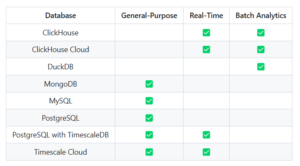
Actual-time analytics pushes the boundaries on information that distributed {hardware} and software program can ship. To adequately measure the relative efficiency of real-time analytics databases, Timescale at this time launched a real-time analytics benchmark dubbed RTABench.
Timescale is a real-time analytics database supplier by the use of its flagship providing, TimescaleDB, which is a modified model of Postgres that treats time-series information as a first-class information sort. The software program has been adopted in gaming and different consumer-facing purposes which are uncovered to fast-changing information and require low-latency responses to many concurrent customers.
These three database capabilities–large concurrency, low latency, and real-time updates–are largely what individually the brand new crop of real-time analytics databases from their conventional column-store brethren. Whereas the info warehouses (or information lakes) from distributors like Snowflake and Databricks can adequately deal with ad-hoc queries on huge information units, corporations with real-time analytics wants typically flip to different distributors, corresponding to Timescale, ClickHouse, StarTree, Indicate, StarRocks, Materialize, and others.
“Traditionally, the business has relied on TPC-H and TPC-DS as the usual benchmarks for evaluating analytical databases,” Timescale wrote in its weblog at this time. “They’re designed to simulate enterprise intelligence and determination help techniques that run advanced, ad-hoc analytical queries throughout a number of tables on massive information units.”
Timescale notes that ClickHouse launched ClickBench, a real-time analytics benchmark. A number of dozen databases have taken the take a look at because it launched in 2022, with the Umbra database presently holding the primary place. TimescaleDB reveals 5 entries within the ClickBench outcomes, the place it sits within the backside 25%.
Whereas ClickBench has obtained fairly a little bit of consideration, the parents at Timescale weren’t solely pleased with it. The corporate says that the way in which ClickBench evaluates databases–by “utilizing a single desk of clickstream information, consultant of workloads like net analytics, BI, and log aggregation”–isn’t conducive to the a good listening to on the total breadth of real-time analytic workloads.
“It [ClickBench] additionally favors full-table massive scans and large-scale aggregations on denormalized information,” Timescale says in its weblog. “Full desk scans and enormous aggregations on a single denormalized desk don’t successfully symbolize the question patterns in purposes delivering real-time analytics.”
So Timecale developed its personal benchmark to higher deal with the real-world workloads that it sees real-time analytics being requested to run. What makes RTABench completely different is the way it handles behind-the-scenes information duties in real-time analytics databases, corresponding to joins, filters, and pre-aggregations.
As an example, database joins are vital to convey collectively tables storing disparate information, corresponding to occasion information and metadata, Timescale says. “You want quick joins on recent information to retrieve associated data from a number of tables,” the corporate writes within the weblog.
Filtering and indexing are different frequent database methods to keep away from the dreaded full-table scans. “Databases constructed for real-time purposes should excel at indexing, partitioning, and quick lookups–not simply bulk aggregations over massive datasets,” Timescale writes.
Pre-aggregations are one other frequent approach to pace up the inevitable queries that can come down the pike. “Present benchmarks like ClickBench don’t benchmark pre-aggregation,” Timescale writes, “however many real-time purposes rely upon it for sub-second response occasions.”
To develop RTABench, Timescale began with the open supply ClickBench framework, after which modified it with completely different information and queries. It additionally created RTABench to work on normalized information (i.e. information straight from the database), versus engaged on denormalized information, as ClickBench has achieved.
The database that Timescale created for the benchmark accommodates 171 million order occasions, about 1,100 prospects, greater than 9,250 merchandise, and about 10 million historic orders. Timescale then created 40 queries which are designed to check how the database handles frequent duties, corresponding to counting the variety of departed shipments per day from a selected terminal, discovering the final recorded standing of a given order, or exhibiting the whole income generated by every buyer within the final 30 days.
“RTABench is a brand new benchmark we have now developed to judge databases utilizing question patterns that mirror real-world utility workloads–one thing lacking from present benchmarks,” Timescale says in its weblog. “Not like ClickBench and different benchmarks, RTABench intently displays the precise wants of real-time analytics purposes, measuring key elements corresponding to joins, selective filtering, and pre-aggregations.”
The corporate determined to depart out a number of measurements. As an example, whereas pre-aggregation queries utilizing incrementally up to date materialized views is a vital function of its database, solely TimescaleDB and ClickHouse presently help these options, so it left that out. It additionally omitted information ingest and high-concurrency queries.
“These additions would add lots of complexity, make the benchmark a lot tougher and longer to run, and introduce extra variance within the outcomes, making them tougher to breed and interpret,” the corporate famous. “We’ve determined to depart these out to make the benchmark simpler to make use of, however we’ll discover methods so as to add them whereas retaining the benchmark easy to run and interpret.”
The corporate is publishing the outcomes of RTABench checks at rtabench.com. TimescaleDB, Clickhouse, MongoDB, Postgres, and MySQL presently are the one databases which have been examined. The corporate is overtly soliciting folks to assist with the mission. You’ll be able to learn extra on the corporate’s weblog publish.
Associated Objects:
Slicing and Dicing the Actual-Time Analytics Database Market
TimescaleDB Is a Vector Database Now, Too
Actual-Time Analytics Databases Emerge to Take On Massive, Quick-Transferring Knowledge
